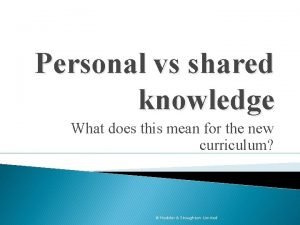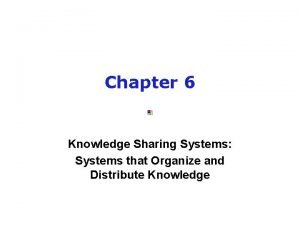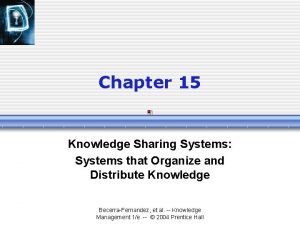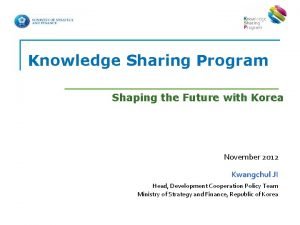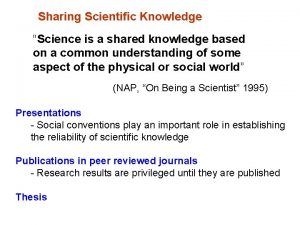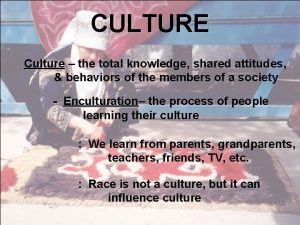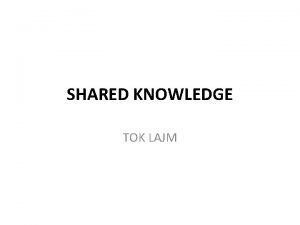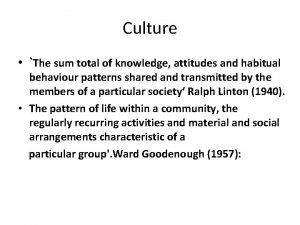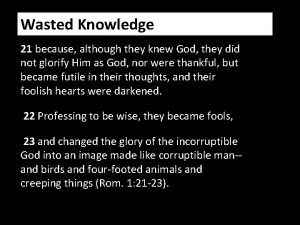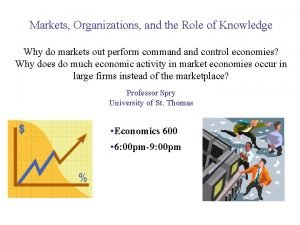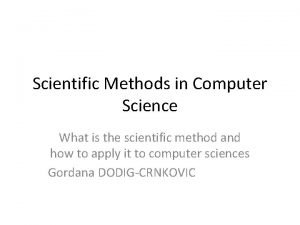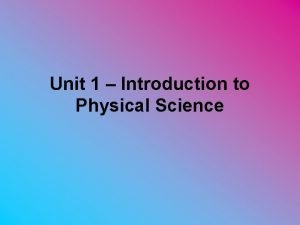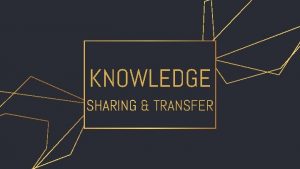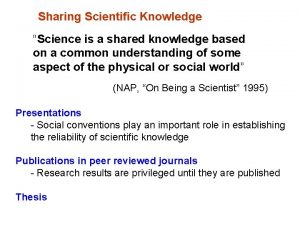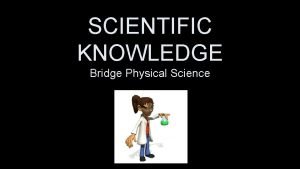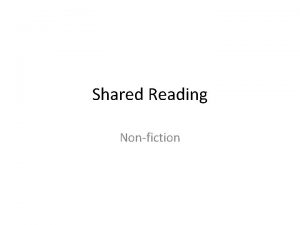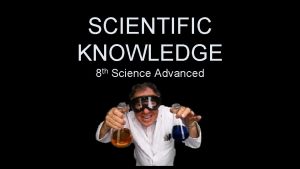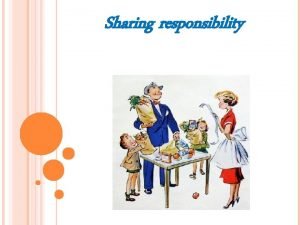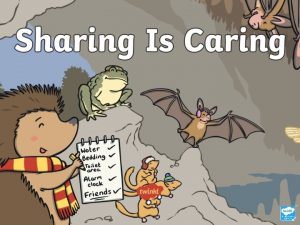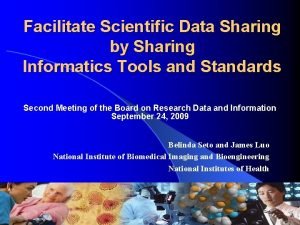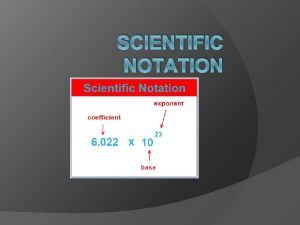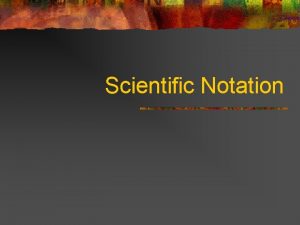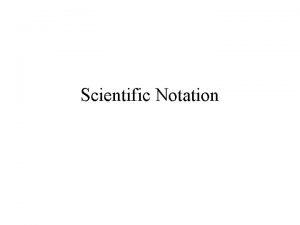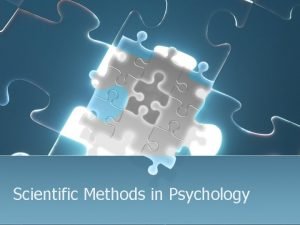Sharing Scientific Knowledge Science is a shared knowledge























- Slides: 23

Sharing Scientific Knowledge “Science is a shared knowledge based on a common understanding of some aspect of the physical or social world” (NAP, “On Being a Scientist” 1995) Presentations - Social conventions play an important role in establishing the reliability of scientific knowledge Publications in peer reviewed journals - Research results are privileged until they are published Thesis

Why Publish? • “A paper is an organized description of hypotheses, data and conclusions, intended to instruct the reader. If your research does not generate papers, it might just as well not have been done” (G. Whitesides, Adv. Mater. , 2004, 16, 1375) • “if it wasn’t published, it wasn’t done” - in E. H. Miller 1993

Scientific Publication is a Team Effort Journal Authors Reviewer ACS Journals: http: //pubs. acs. org/about. html

Author Responsibilities – Preparation and Submission of Manuscripts: Follow General Rules: – Ensure work is new and original research – All Authors listed on ms are aware of submission and agree with content and support submission – Agree that the manuscript can be examined by anonymous reviewers. – Provide copies of related work submitted or published elsewhere – Obtain copyright permission if figures/tables need to be reproduced – Include proper affiliation

What is publishable…. Journals like to publish papers that are going to be widely read and useful to the readers • Papers that report “original and significant” findings that are likely to be of interest to a broad spectrum of its readers • Papers that are well organized and well written, with clear statements regarding how the findings relate to and advance the understanding/development of the subject • Papers that are concise and yet complete in their presentation of the findings

What is not acceptable… • Papers that are routine extensions of previous reports and that do not appreciably advance fundamental understanding or knowledge in the area • Incremental / fragmentary reports of research results • Verbose, poorly organized, papers cluttered with unnecessary or poor quality illustrations • Violations of ethical guidelines, including plagiarism of any type or degree (of others or of oneself)

Useful Definitions: Scientific Misconduct “Scientific misconduct means fabrication, falsification, plagiarism, or other practices that seriously deviate from those that are commonly accepted within the scientific community for proposing, conducting or reporting research” Managing Allegations of Scientific Misconduct: A Guidance Document for Editors, January 2000, Office of Research Integrity, Office of Public Health and Science, U. S. Dept. of Health and Human Services http: //ori. dhhs. gov

Useful Definitions: Plagiarism and Self-Plagiarism • Plagiarism: using the ideas or words of another person without giving appropriate credit (Nat. Acad. Press document) • Self-Plagiarism: The verbatim copying or reuse of one’s own research (IEEE Policy statement) Both types of plagiarism are considered to be unacceptable practice by most scientific publications

Other Types of Ethical Violations • Duplicate publication/submission of research findings; failure to inform the editor of related papers that the author has under consideration or “in press” • Unrevealed conflicts of interest that could affect the interpretation of the findings • Misrepresentation of research findings use of selective or fraudulent data to support a hypothesis or claim

Sooner or later ……. ethical violations get exposed Some recent examples

24 MAY 2002 VOL 296 SCIENCE, p 1376

24 MAY 2002 VOL 296 SCIENCE, p 1376

A recent retraction …. . Ethical Responsibilities for Authors in The Journal of Physical Chemistry I recently took the step of retracting from the scientific record a letter published in The Journal of Physical Chemistry C, as it is emblematic of a type of author misconduct that we as research professionals must seek to avoid if we are to uphold the integrity of the scientific literature. The letter in question was a publication by Fang et al. , J. Phys. Chem. C 2007, 111, 1065 -1070. After publication of the letter, it was brought to our attention that the paper by Fang et al. , as submitted and subsequently published by the journal after peer review, included a number of figures that duplicated those contained within previously published papers by other authors ……. . . I judged such misconduct by the authors to constitute a serious instance of plagiarism. George Schatz Editor in Chief J. Phys. Chem. A/B/C

Original paper: Ultra-large-scale syntheses of monodisperse nanocrystals, Park et al. Nature Materials, 2004, 3, 891 (Figure 3 C) Original Paper Oriented Assembly of Fe 3 O 4 Nanoparticles into Monodisperse Hollow Single-Crystal Microspheres Yu et al, J. Phys. Chem. B 2006, 110, 21667 -21671 (Figure 3) Plagiarized paper: Fabrication of Monodisperse Magnetic Fe 3 O 4 -Si. O 2 Nanocomposites with Core-Shell Structures Hua Fang, * Chun-yang Ma, Tai-li Wan, Mei Zhang, and Wei-hai Shi J. Phys. Chem C 2007, 111, 1065 -1070


Citations -Read the work before you cite -Important to cite the work correctly and completely NATURE|VOL 420 | 12 DECEMBER 20002 p 594

The Chronicle of Higher Education, August 11, 2006 Also in Wall Street Journal –today’s issue (40% students use materials downloaded from internet!) The Plagiarism Hunter When one graduate student went to the library, he found copycats — lots of them By PAULA WASLEY, Athens, Ohio In Ohio University's Library, Thomas A. Matrka takes just 15 minutes to hit pay dirt. Scattered before him on a table are 16 chemical-engineering master's theses on "multiphase flow. “ Identical diagrams in two theses from 1997 and 1998 strike him as suspicious. Turning a few more pages, he confirms what he suspected………. . Most of the plagiarism found at Ohio occurred in introductory chapters describing research methods and reviewing the previous literature in the field, for which there is little expectation of originality. And all but a few cases involved international students who, he says, whether through ignorance, laziness, or cultural misunderstanding, may have either not known correct citation practices or, struggling to write in a foreign language, been tempted to borrow another student's words.

How Journals Detect and Handle Problem Papers Ø Information received from reviewers or other editors Ø Literature search for related papers by the author v Withdrawal of a paper from publication v Banning authors from publication in the journal for 3 -5 years and informing the co-authors and editors of related journals of our action v For less serious cases, placing the author on a “watch list” for careful examination of their submissions prior to requesting reviews

RETRACTED: Fluorescence lifetime increase by introduction of F− ions in ytterbium-doped Te. O 2 based glasses Journal of Alloys and Compounds, Volume 393, Issues 12, 3 May 2005, Pages 279 -282 Guonian Wang, Shixun Dai, Junjie Zhang, Shiqing Xu and Zhong Jiang R T C A R T E D E RETRACTED: Effect of F− ions on spectroscopic properties of Yb 3+-doped zinc–tellurite glasses • Journal of Physics and Chemistry of Solids, Volume 66, Issue 6, June 2005, Pages 1107 -1111 Guonian Wang, Junjie Zhang, Shixun Dai, Jianhu Yang and Zhong Jiang From Science@Direct (Elsevier)

Guidelines For Authors and Scientists Ø Ethical Guidelines to Publication of Chemical Research (ACS Pubs. Div. ) - available via Paragon or ACS Journals web site Ø “On Being a Scientist: Responsible Conduct in Research”; National Academy Press, Wash. D. C, 1995 (http: //www. nap. edu/readingroom/books/obas/) Ø IEEE Policy Statement on Self-Plagiarism (http: //www. comsoc. org/pubs/jrnal/transcom/Self_Plagiaris m. pdf) Ø Managing Allegations of Scientific Misconduct: A Guidance Document for Editors, January 2000, Office of Research Integrity, Office of Public Health and Science, U. S. Dept. of Health and Human Services http: //ori. dhhs. gov

EDITOR The Journal of Physical Chemistry George C. Schatz, Editor in Chief Bridgette Barry Georgia Institute of Technology SENIOR EDITORS Anne B. Mc. Coy The Ohio State University Michael A. Duncan University of Georgia Timothy Minton Montana State University Peter M. Felker University of California, Los Angeles Catherine J. Murphy University of South Carolina John T. Fourkas University of Maryland Benjamin J. Schwartz University of California, Los Angeles Sharon Hammes-Schiffer The Pennsylvania State University Sarah H. Tolbert University of California, Los Angeles Kenneth D. Jordan University of Pittsburgh Paul H. Wine Georgia Institute of Technology Prashant V. Kamat University of Notre Dame Jin Z. Zhang University of California; Santa Cruz James M. Lisy University of Illinois/Urbana-Champaign Josef W. Zwanziger Dalhousie University, Canada Gang-yu Liu University of California at Davis Timothy S. Zwier Purdue University

The Journal of Physical Chemistry Scientific Publication is a Team Effort Editorial Office Author Reviewer Submission, Editorial Screening, Reviewing and Editorial Decision Processes are similar to those presented in previous talks

Thank you B
 What is shared knowledge
What is shared knowledge Knowledge shared is knowledge squared
Knowledge shared is knowledge squared Knowledge shared is knowledge multiplied meaning
Knowledge shared is knowledge multiplied meaning Knowledge claim
Knowledge claim My favorite subject
My favorite subject Knowledge sharing systems
Knowledge sharing systems What are knowledge sharing systems
What are knowledge sharing systems Knowledge sharing program korea
Knowledge sharing program korea Sharing knowledge and expertise
Sharing knowledge and expertise Knowledge sharing center
Knowledge sharing center Shared knowledge
Shared knowledge The total knowledge shared attitudes and behaviors
The total knowledge shared attitudes and behaviors Task tok
Task tok Culture is sum total of
Culture is sum total of Knowledge not shared is wasted
Knowledge not shared is wasted Scientific inquiry vs scientific method
Scientific inquiry vs scientific method How is a scientific law different from a scientific theory?
How is a scientific law different from a scientific theory? Examples of scientific knowledge
Examples of scientific knowledge Www.sciencebuddies.org
Www.sciencebuddies.org Skills in science
Skills in science Scientific methods in computer science
Scientific methods in computer science Physical science scientific notation worksheet answers
Physical science scientific notation worksheet answers George gopen
George gopen Knowledge creation and knowledge architecture
Knowledge creation and knowledge architecture



